 Jeffrey Kastner
Jeffrey Kastner
A video installation focusing on a catastrophic collision in American football history touches upon themes of violence, professional sports culture, and the strangeness of bodily experience.
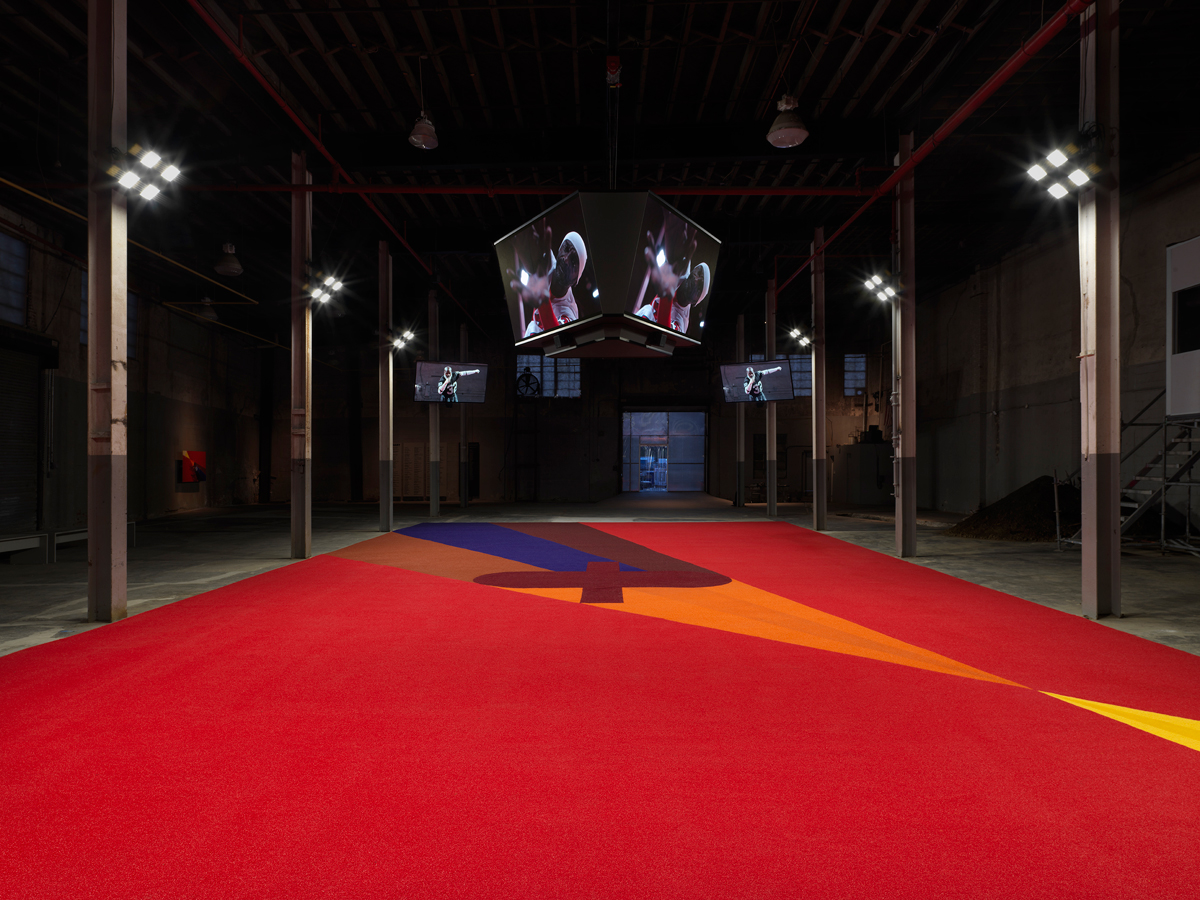
Matthew Barney: Secondary, installation view. Courtesy the artist, Gladstone Gallery, Galerie Max Hetzler, Regen Projects, and Sadie Coles HQ. Photo: Dario Lasagni. © Matthew Barney.
Matthew Barney: Secondary, Matthew Barney Studio, 4–40 Forty-Fourth Drive, Long Island City, through June 25, 2023
• • •
I went to see Matthew Barney’s Secondary on the first Wednesday in June, the day New York was reduced to a blur by smoke fuming south from the Canadian wildfires. Walking through the acrid haze toward the pier where the video installation is on view—in the artist’s former studio, the same cavernous warehouse on the Queens shore of the East River where it was staged and filmed—it started to feel like Barney himself might well have orchestrated the unheimlich atmospherics, the sort that have populated his work for some thirty years. I arrived half expecting something to match the weather: another claustrophobic biopsychological phantasmagoria, maybe, or one of his rococo exercises in mythic exegesis. But it quickly became clear that Secondary instead represents a further step in his oeuvre toward a notional realism—that is, an approach that depends less on the endless profusion of symbolically freighted grotesqueries than on strategically pressurizing the strangeness available IRL until it begins to leak beyond the precincts of strict facticity.
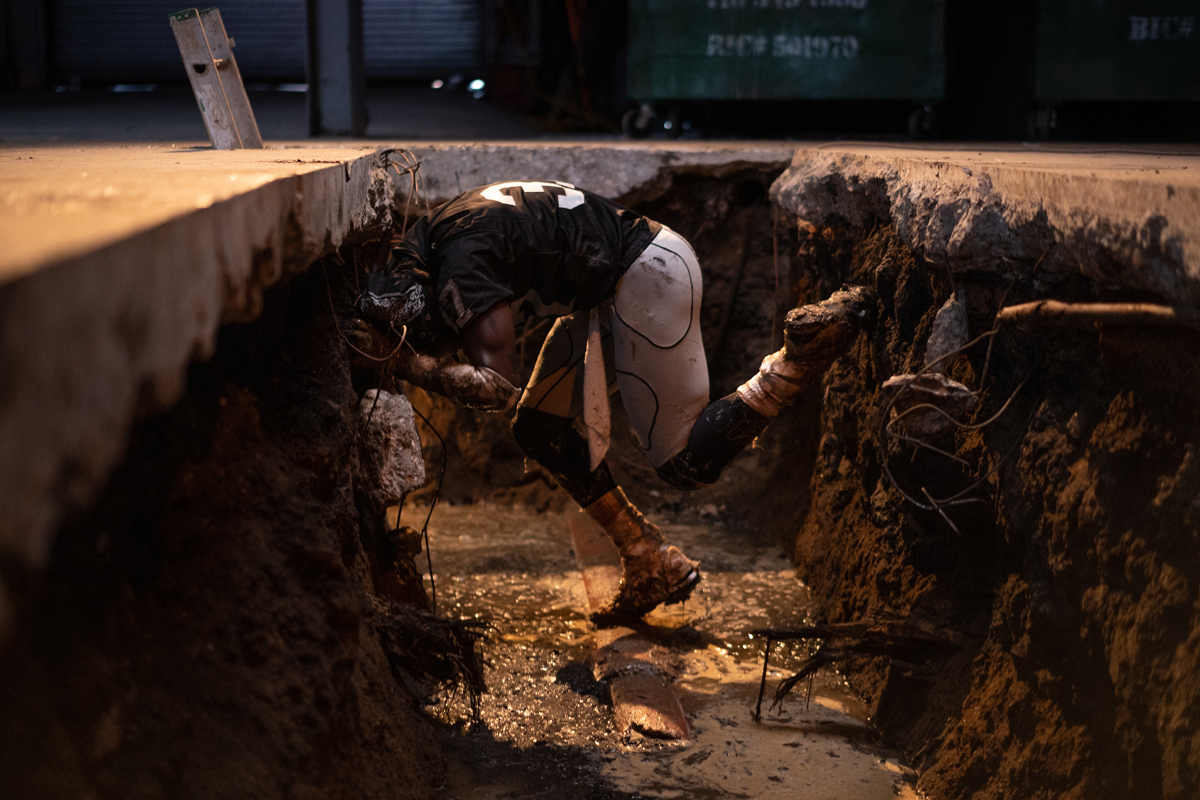
Matthew Barney, Secondary, 2023 (production still). Five-channel video installation with sound, 60 minutes. Photo: Jon O’Sullivan. © Matthew Barney.
Barney’s last major project was Redoubt (2018), a loose reimagining of the story of Diana and Actaeon set in the Sawtooth Mountains, near the artist’s childhood home of Boise. Though stuffed to bursting with themes and ideas, from wildlife management and survivalism to alchemy and astronomy, in comparison to what came before it—the implausibly demanding five-and-a-half-hour-long Rabelaisian shitshow that was 2014’s River of Fundament—Redoubt felt eminently digestible, and, at just 134 minutes, almost pithy in its narrative scope. With Secondary, this conceptual focus is extended even further. Clocking in at exactly one hour, the five-channel piece takes as its central subject a single incident, one of the most replayed moments in the history of American football: the 1978 collision between Oakland Raiders defensive back Jack Tatum and New England Patriots wide receiver Darryl Stingley, a hit that severely injured Stingley’s spinal cord, leaving the twenty-six-year-old quadriplegic for the rest of his life.
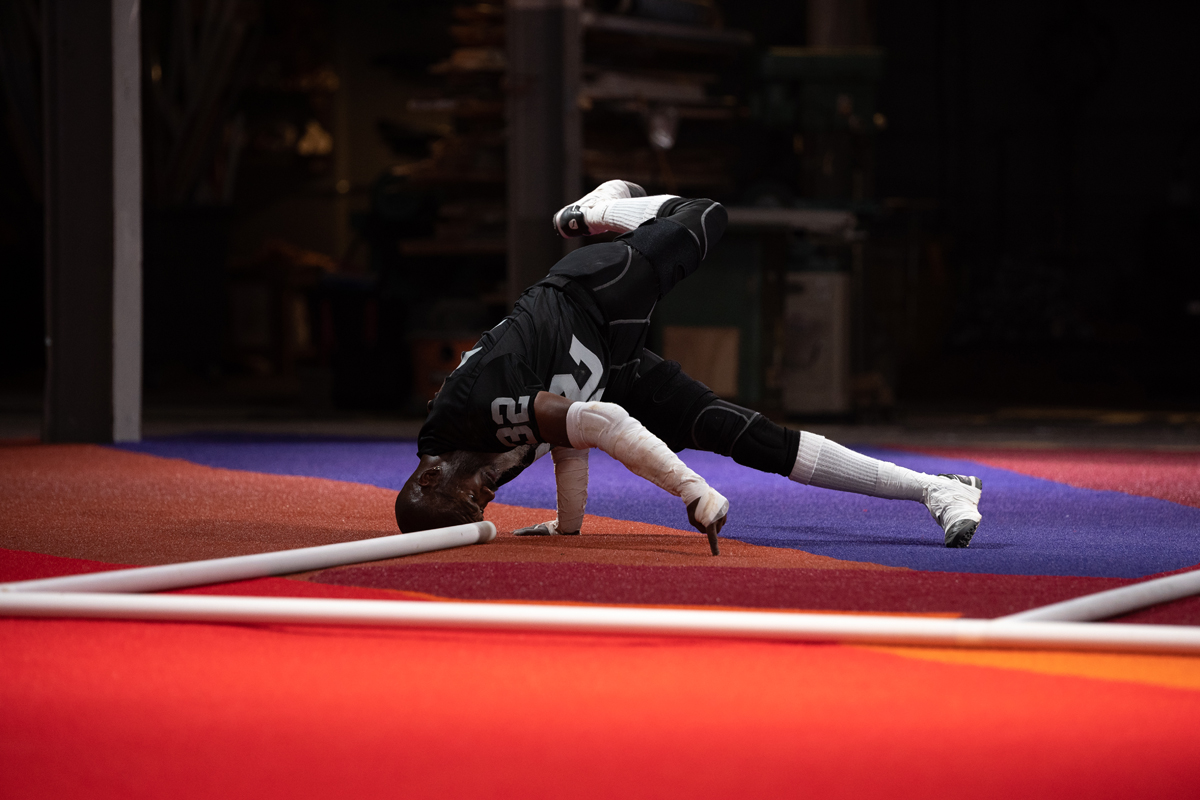
Matthew Barney, Secondary, 2023 (production still). Five-channel video installation with sound, 60 minutes. Photo: Jon O’Sullivan. © Matthew Barney.
As with the Idaho setting of Redoubt, Secondary’s subject matter represents something of a return for Barney. A star quarterback in high school, he was originally recruited by Yale to play football, and one of the most indelible sequences from his Cremaster cycle (1994–2002) involves an unsettling Busby Berkeley–style routine filmed on and around the uniquely blue field of the Boise State University football stadium. In Long Island City, the playing surface was similarly colorized to suggest vectors of movement and force, its design centered on Barney’s so-called Field Emblem, a type of heraldic symbol, in the form of a bisected ellipse, for a body simultaneously in action and subjected to physical constraint. Barney filmed the “game” action on this springy, rainbow-hued artificial turf, which now fills and demarcates the exhibition space. Viewers can sit or stand on it to take in the video work, unfolding across several screens: four channels run on four different monitors installed around the carpet’s perimeter, while one channel plays on the three sides of a jumbotron-like unit hanging from the ceiling in the center of the space.

Matthew Barney, Secondary, 2023 (production still). Five-channel video installation with sound, 60 minutes. Photo: Julieta Cervantes. © Matthew Barney.
The video’s principal narrative is motored by a cast of dancers and movement artists, mainly middle-aged men, who play the roles of Stingley’s teammates and adversaries from the day he was paralyzed. Often shown in authentic uniform gear, with identifying names on their backs, these superbly talented performers take to the Technicolor turf for an inscrutable choreography that weaves together yogic poses and calisthenics with modes of krump and break dance to evoke practice drills, pregame routines, and in-game behaviors. A second narrative runs parallel to this one, in which the players appear in other areas of the building (vacant now, but still active parts of Barney’s studio at the time the work was made), engaging in cryptic activities with aluminum, lead, terracotta, and a good deal of plasticky goop. They deploy the resulting sculptural props to limit, obstruct, and otherwise deform their own and each other’s motions.

Matthew Barney, Secondary, 2023 (production still). Five-channel video installation with sound, 60 minutes. Photo: Julieta Cervantes. © Matthew Barney.
The two men involved in the controversial play—the sort of vicious but legal hit the Raider safety, nicknamed “the Assassin,” was renowned for—are portrayed by multidisciplinary artists Raphael Xavier (Tatum) and David Thomson (Stingley), the latter of whom also served as the production’s movement director. But while their fateful encounter is both the conceptual inspiration for and narrative heart of Barney’s enterprise, it occupies only a brief passage in the complex composition of the overall performance. Structured by the temporal rhythms of a football game, with four fifteen-minute quarters (tallied by an oversize stadium-style digital clock affixed to the warehouse’s facade), the work is largely concerned with ancillary activities: the wordless conversations of a trio of game officials, whose vocalizations bring to mind the distant blips and burbles of adults in Peanuts cartoons; the fanatical routines of the comically fearsome members of Raider Nation, dressed (in the manner of the team’s actual fervent supporters) like a zombified death-metal band; the enigmatic ministrations of Al Davis (Thomas Kopache), the cantankerous owner of the Raiders at the time, here figured as a kind of ancient custodian; an extraordinary, keening vocal performance by Chiricahua Apache and Isleta Pueblo soprano Jacquelyn Deshchidn that turns the national anthem comprehensively against itself, reshaping its overly familiar contours into something deeply alien; and a sequence of peculiar undertakings executed by various cast members inside a cramped, grave-like depression cut into the building’s floor, where a broken pipe is submerged in, and sometimes emerges from, brackish water that rises and falls with the tide.
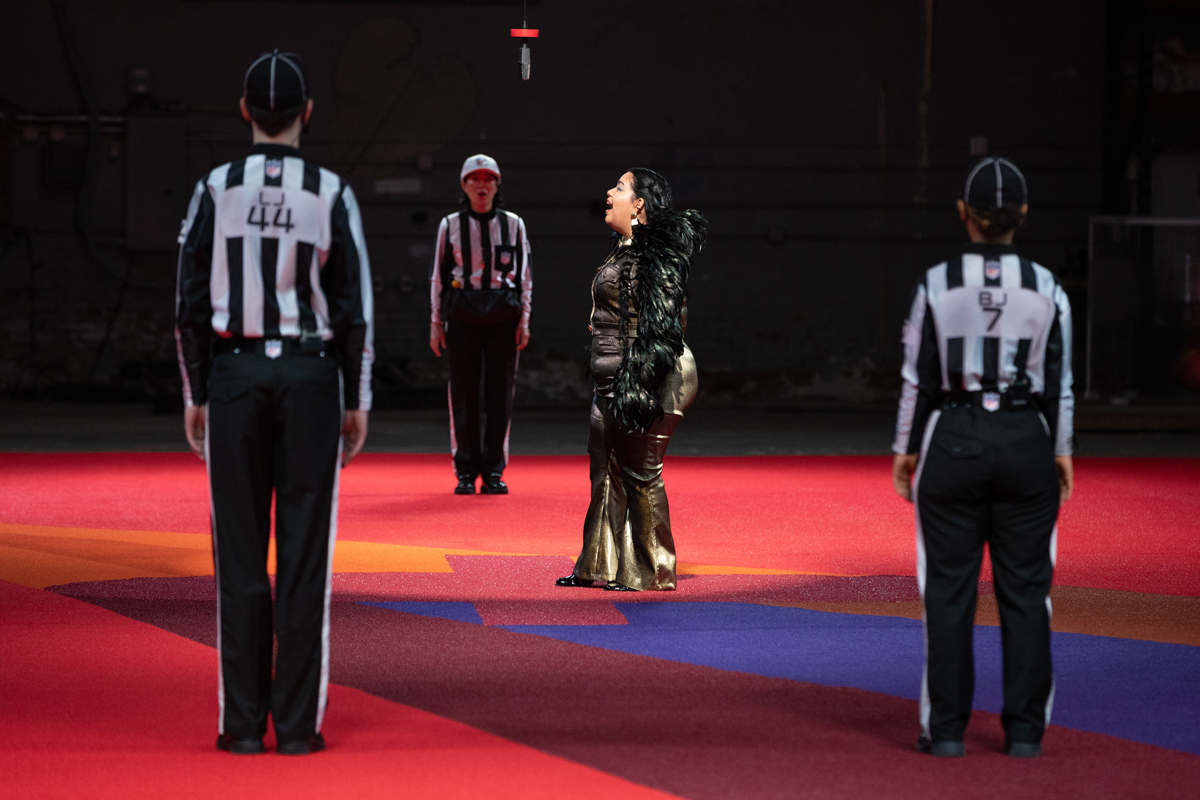
Matthew Barney, Secondary, 2023 (production still). Five-channel video installation with sound, 60 minutes. Photo: Julieta Cervantes. © Matthew Barney.
As usual, Barney is part of the ensemble. Cast as Raiders quarterback Ken Stabler, the artist spends the first part of the video disassembling his helmet, extracting the protective lining inside of it and then messily wrapping the padding around his head; later, he’ll throw himself backward onto the ground, as though sacked by an invisible demon. (Stabler suffered later in life from chronic traumatic encephalopathy, a degenerative neurological condition linked to the sport’s brutal impacts—another instance of the violence utterly central to fans’ dogged devotion to “America’s game,” as it is to Secondary.) When, in the final quarter of the piece, Tatum and Stingley collide, the instant is sculpturally embodied by three carapaces that suddenly appear at the point of contact between their bodies in a sequence of reiterations framed from different perspectives. The shapes fall to the floor following their apparent production amid the malign energies of the clash. While the first two seem to be made from some sort of pliable plastic material, the final one is terracotta, which shatters when it lands—like the fractured subterranean plumbing visible in the trench, another bluntly signaled evocation of Stingley’s injury.
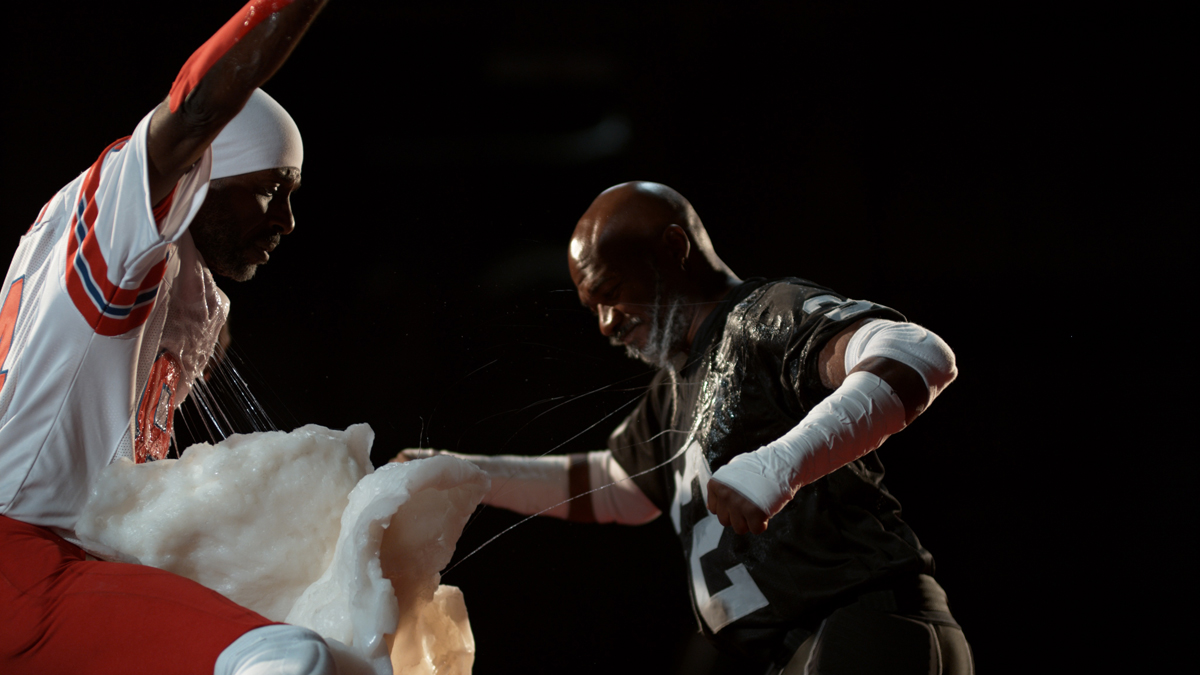
Matthew Barney, Secondary, 2023 (film still). Five-channel video installation with sound, 60 minutes. Photo: Soren Nielsen. © Matthew Barney.
In a 2006 interview, Barney spoke as an athlete-turned-artist about the sensory duality of football, the way the game is simultaneously experienced both in elevation—“seeing across the field and . . . locating . . . holes in the defense from the ground perspective”—and in plan, which is to say from above, as the game is taught and analyzed. What he found most compelling in retrospect, he said, was the strange “out-of-body experience” that oscillation produced. The practical dynamics of this fundamentally Cartesian duality—a categorically physical game arguably best understood abstractly, at an analytical remove—have, writ large, always been the crux of Barney’s work, with its stew of nature and culture, science and mythos, its deeply philosophical figuring of the most basic aspects of corporeality. In Secondary, the body/mind split that has so occupied his significant artistic energies is staged via a catastrophic incident that literally ruptured that part of an individual responsible for conducting the exchange between those two halves of his being. The whole enterprise finally feels like something of an origin story for Barney’s own inimitable practice—one that brings together the somatic and the cerebral in a fully organic way.
Jeffrey Kastner is a New York–based writer and critic, the senior editor of Cabinet magazine, and a contributing editor of Places Journal. His books include the edited volumes Land and Environmental Art (Phaidon) and Nature (MIT/Whitechapel), and he is coauthor, with Claire Lehmann, of Artists Who Make Books (Phaidon). A regular contributor to Artforum, his writing has appeared in publications including the Economist, frieze, the New Republic, and the New York Times, and in books and exhibition catalogues on artists such as David Altmejd, Ragnar Kjartansson, Tomas Saraceno, and Sarah Sze.